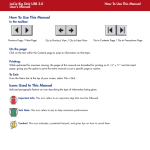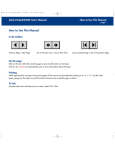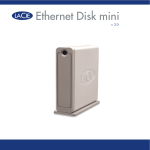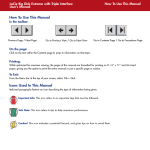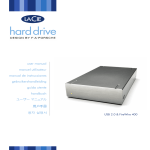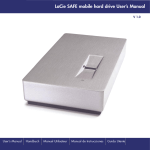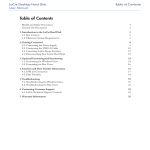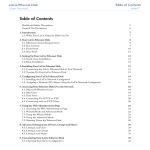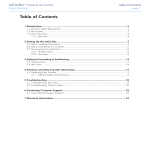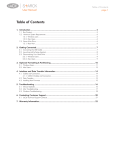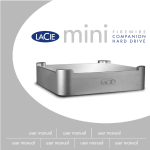Download Product Manual
Transcript
LaCie SAFE Mobile Hard Drive with encryption User’s Manual How To Use This Manual How To Use This Manual In the toolbar: Previous Page / Next Page Go to Beginning / Go to End Printing: While optimized for onscreen viewing, the pages of this manual are formatted for printing on 8 1/2" x 11" and A4 sized paper, giving you the option to print the entire manual or just a specific page or section. To Exit: For Windows: From the Menu Bar at the top of your screen, select: File > Quit. For Mac: From the Menu Bar at the top of your screen, select Acrobat > Quit Acrobat. Icons Used In This Manual Italicized paragraphs feature an icon describing the type of information being given. Important Info: This icon refers to an important step that must be followed. Tech Note: This icon refers to tips to help maximize performance. Caution! This icon indicates a potential hazard, and gives tips on how to avoid them. LaCie SAFE Mobile Hard Drive with encryption User’s Manual Table of Contents Foreword Health and Safety Precautions 4 6 1. Introduction 7 1.1. What Your LaCie SAFE Drive Can Do 2. Unpacking Your LaCie SAFE Drive 2.1. What’s Included With Your LaCie SAFE Drive 2.2. Minimum System Requirements 3. Before Installing Your SAFE Drive 3.1. How to Use the Fingerprint Sensor 3.2. The Configuration Tool 3.3. About Authorized Users and Rights 3.4. Rules for Registering Users 3.5. About Encryption Levels 4. Connecting Your SAFE Drive 4.1. Connect the USB 2.0* Cable to Your LaCie Drive and to Your Computer 4.2. Connecting the USB Power Sharing Cable 5. Setting Up Your LaCie SAFE Drive 5.1. Installing the SAFE Drive Software 5.2. Setting Up the Pass Phrase and Encryption Mode 5.3. Setting User Names and Permissions 5.4. Registering User Fingerprints 5.5. Registering Additional Users 5.6. Finishing the Installation 6. Using Your LaCie SAFE Drive 6.1. Using the Drive as a Registered User 6.1.1. Mac Installation 6.1.2. Accessing the Configuration Tool 6.1.3. Entering the Pass Phrase 6.2. The User Management Window 6.2.1. Adding a New User 6.2.2. Removing a User 6.2.3. Changing a User Profile 7 8 8 8 9 9 9 9 10 10 12 12 13 14 14 17 20 21 23 23 25 25 26 27 27 28 28 29 30 LaCie SAFE Mobile Hard Drive with encryption User’s Manual 6.3. Reset to Factory Default 6.4. Using Multiple SAFE Drives on the Same Computer 6.5. Disconnecting and Locking the Drive 7. Helpful Information 7.1. File System Formats 7.1.1. Windows Users 7.1.2. Mac Users 7.2. Formatting Your LaCie Hard Drive 7.2.1. Windows Users 7.2.2. Mac Users 7.2.3. Reformatting in HFS+ for Mac OS 10.3 7.3. Optimizing USB 2.0 Connections 7.3.1. What is USB 2.0? 7.3.2. Data Transfers Table of Contents 31 33 33 34 34 34 35 36 36 38 39 41 41 42 8. Frequently Asked Questions (FAQ) 43 9. Troubleshooting Your LaCie Drive 45 10. Troubleshooting the Fingerprint Sensor 49 11. Contacting Customer Support 50 12. Warranty 52 Glossary 53 LaCie SAFE Mobile Hard Drive with encryption User’s Manual Foreword page 4 Copyrights Copyright © 2005 LaCie. All rights reserved. No part of this publication may be reproduced, stored in a retrieval system, or transmitted in any form or by any means, electronic, mechanical, photocopying, recording or otherwise, without the prior written consent of LaCie. Trademarks Apple, Mac and Macintosh are registered trademarks of Apple Computer, Inc. Microsoft, Windows 2000 and Windows XP are registered trademarks of Microsoft Corporation. Other trademarks mentioned in this manual are the property of their respective owners. Changes The material in this document is for information only and subject to change without notice. While reasonable efforts have been made in the preparation of this document to assure its accuracy, LaCie assumes no liability resulting from errors or omissions in this document, or from the use of the information contained herein. LaCie reserves the right to make changes or revisions in the product design or the product manual without reservation and without obligation to notify any person of such revisions and changes. FCC Statement: Caution! Modifications not authorized by the manufacturer may void the user’s authority to operate this device. NOTE: This equipment has been tested and found to comply with the limits for a Class A digital device, pursuant to Part 15 of the FCC Rules. These limits are designed to provide reasonable protection against harmful interference when the equipment is operated in a commercial environment. This equipment generates, uses, and can radiate radio frequency energy and, if not Tested To Comply installed and used in accordance with the instruction manual, may cause harmful With FCC standards interference to radio communications. Operation of this equipment in a residential area is likely to cause harmful interference in which case the user will be required to correct the interference at his own expense. FOR HOME OR OFFICE USE NOTE: This equipment has been tested and found to comply with the limits for a Class B digital device, pursuant to Part 15 of the FCC Rules. These limits are designed to provide reasonable protection against harmful interference in a residential installation. This equipment generates, uses and can radiate radio frequency energy and, if not installed and used in accordance with the instructions, may cause harmful interference to radio communications. However, there is no guarantee that interference will not occur in a particular installation. If this equipment does cause harmful interference to radio or television reception, which can be determined by turning the equipment off and on, the user is encouraged to try and correct the interference by one or more of the following measures: • Reorient or relocate the receiving antenna. • Increase the separation between the equipment and receiver. • Connect the equipment into an outlet on a circuit different from that to which the receiver is connected. • Consult the dealer or an experienced radio/TV technician for help. LaCie SAFE Mobile Hard Drive with encryption User’s Manual Foreword page 5 Canada Compliance Statement This Class A digital apparatus meets all requirements of the Canadian Interference-Causing Equipment Regulations. Manufacturer’s Declaration for CE Certification We, LaCie, hereby certify that this device is in compliance with both the EMC Directive (89/336/EEC) and the Low Voltage Directive (73/23/EEC) issued by the Commission of the European Community. Compliance with these directives implies conformity to the following European Norms: Class B EN60950, EN50082-1, EN61000-3-2 With reference to the following conditions: 73/23/EEC Low Voltage Directive 89/336/EEC EMC Directive LaCie SAFE Mobile Hard Drive with encryption User’s Manual Precautions page 6 Health and Safety Precautions Only qualified persons are authorized to carry out maintenance on this device. • Read this User's Guide carefully, and follow the correct procedure when setting up the device. • Do not open your LaCie SAFE mobile hard drive or attempt to disassemble or modify it. Never insert any metallic object into the drive to avoid any risk of electrical shock, fire, short-circuiting or dangerous emissions. Your LaCie SAFE mobile hard drive contains no user-serviceable parts. If it appears to be malfunctioning, have it inspected by a qualified LaCie Technical Support representative. • Never expose your device to rain, or use it near water, or in damp or wet conditions. Never place objects containing liquids on the LaCie SAFE mobile hard drive, as they may spill into its openings. Doing so increases the risk of electrical shock, short-circuiting, fire or personal injury. General Use Precautions: • Do not expose the LaCie SAFE mobile hard drive to temperatures outside the range of 5° C to 45° C (41° F to 104° F). Doing so may damage the hard drive or disfigure its casing. Avoid placing your LaCie hard drive near a source of heat or exposing it to sunlight (even through a window). Inversely, placing your LaCie hard drive in an environment that is too cold or humid may damage the unit. • Always unplug the LaCie SAFE mobile hard drive from the electrical outlet if there is a risk of lightning or if it will be unused for an extended period of time. Otherwise, there is an increased risk of electrical shock, short-circuiting or fire. • If an external power supply is needed, please use only the optional AC power adapter from LaCie. • Do not use the LaCie SAFE mobile hard drive near other electrical appliances such as televisions, radios or speakers. Doing so may cause interference which will adversely affect the operation of the other products. • Do not place the LaCie SAFE mobile hard drive near sources of magnetic interference, such as computer displays, televisions or speakers. Magnetic interference can affect the operation and stability of your LaCie hard drive. • Do not place heavy objects on top of the LaCie SAFE mobile hard drive or use excessive force on it. • Never use excessive force on your LaCie SAFE mobile hard drive. If you detect a problem, consult sections 9. Troubleshooting Your LaCie Drive and 10. Troubleshooting the Fingerprint Sensor in this manual. • Protect your LaCie SAFE mobile hard drive from excessive exposure to dust during use or storage. Dust can build up inside the device, increasing the risk of damage or malfunction. • Never use benzene, paint thinners, detergent or other chemical products to clean the outside of the LaCie SAFE mobile hard drive. Such products will disfigure and discolor the casing. Instead, use a soft, dry cloth to wipe the device. Caution! The LaCie SAFE mobile hard drive's warranty may be void as a result of the failure to respect the precautions listed above. LaCie SAFE Mobile Hard Drive with encryption User’s Manual 1. Introduction page 7 1. Introduction Congratulations on the purchase of your new LaCie SAFE mobile hard drive! By simply plugging the LaCie SAFE mobile hard drive into your computer and stepping through a quick and easy software setup process, you can ensure that your data is secure from unauthorized users. The LaCie SAFE mobile hard drive performs just like a standard external hard drive, but keeps your data secure with a technology known as biometry. This emerging field is devoted to the identification of individuals using biological traits such as fingerprints or voice recognition. Fingerprint scanning, which is the technology used by the SAFE mobile drive, is the most common biometric system used today. To further secure your data, the LaCie SAFE drive encrypts it using the high-level and widely recognized DES algorithm. Unlike software encryption solutions that have been prone to a number of different attacks, the SAFE drive's hardware encryption offers a higher level of protection and information security. The SAFE drive lets you create authorized users, assign access rights and add and remove users. A software wizard guides you step-by-step through the installation process. With all it can do for you, we’re confident that your LaCie SAFE mobile hard drive will quickly become an important storage companion in your day-to-day business and personal computing. 1.1. What Your LaCie SAFE Drive Can Do • Store all of your important data securely • Provide access to data only to authorized users • Allow up to 5 authorized users access to the drive • Register 10 fingerprints • Securely encrypt your data with DES or Triple DES hardware encryption Important Info: Any loss, corruption or destruction of data while using a LaCie drive is the sole responsibility of the user, and under no circumstances will LaCie be held liable for the recovery or restoration of this data. To help prevent the loss of your data, LaCie highly recommends that you keep two copies of your data; one copy on your external hard drive, for instance, and a second copy either on your internal hard drive, another external hard drive or some other form of removable storage media, such as CD, DVD or tape. LaCie offers a complete line of CD, DVD and tape drives. For more information, refer to the LaCie white paper on backup methods. LaCie SAFE Mobile Hard Drive with encryption User’s Manual 2. Unpacking Your LaCie SAFE Drive page 8 2. Unpacking Your LaCie SAFE Drive Building on years of storage experience, LaCie has teamed up with leaders in the security industry to create a new family of drives that can seamlessly keep your most important data secure from prying eyes. These latest drives are performance-based solutions that provide you with the quality you’ve come to expect from LaCie. Whether you want to leave your data securely stored at your office or pack up your drive and take it with you, these drives are the perfect answer for keeping your data both secure and handy. Share between PCs and Macs and register up to five users to securely access the data on your drive. 2.1. What's Included with Your LaCie SAFE Drive 1 LaCie SAFE mobile hard drive 2 Hi-Speed USB 2.0 certified cable 3 USB Power Sharing Cable 4 1 2 LaCie CD-ROM with manual 2.2. Minimum System Requirements 4 3 System Requirements for USB 2.0: • Windows® 2000 and Windows XP OR • Mac OS 10.2.x or higher Hardware Requirements for USB 2.0: • PC or Mac with built-in powered USB bus • 350MHz Intel Pentium II or G3 processor or greater • Minimum 128MB of RAM Tech Note: *To achieve USB 2.0 speeds, your drive must be connected to a USB 2.0 host port. If it is connected to a USB 1.1 port, your drive will operate at USB 1.1 speeds. For more details see section 7.3. Optimizing USB 2.0 Connections. LaCie SAFE Mobile Hard Drive with encryption User’s Manual 3. Before Installing Your SAFE Drive page 9 3. Before Installing Your SAFE Drive Yes, we know you are anxious to start using your new LaCie SAFE mobile hard drive, but because it has extra data security features not found on standard external hard drives, you should take a minute to familiarize yourself with these items first: • 3.1. How to Use the Fingerprint Sensor • 3.2. The Configuration Tool • 3.3. About Authorized Users and Rights • 3.4. Rules for Registering Users • 3.5. About Encryption Levels 3.1. How to Use the Fingerprint Sensor To use the fingerprint sensor, first make sure that the front of the drive is facing you. Next, place your finger so that it is flat and resting entirely on the sensor surface so that it touches the metal plate around the sensor itself. The top of your finger should touch the top edge of the metal groove. Now slide your finger down slowly over the sensor. If you have trouble getting the sensor to recognize your fingerprint, refer to section 10. Troubleshooting the Fingerprint Sensor. 3.2. The Configuration Tool The Configuration Tool allows you to: • Add or remove users. • Assign Read Only or Read/Write privileges to users. • Change a user’s profile. Important Info: You can register more fingerprints per user as long as you don’t exceed a maximum of 10 fingerprints total for all users. So, for example, you could register 2 fingerprints each for 5 users or 10 fingerprints for 1 user or any other combination inbetween. 3.3. About Authorized Users and Rights The Configuration Tool lets you register fingerprints for up to five users. When registering users, you can opt to give them Read Only privileges or Read/Write privileges. Read Only privileges allow a user to read data stored on the drive but not to write new data to the drive. This user cannot modify data or remove files. Read/Write privileges allow a user to both read data stored on the drive as well as write new data to it. LaCie SAFE Mobile Hard Drive with encryption User’s Manual 3. Before Installing Your SAFE Drive page 10 3.4. Rules for Registering Users The LaCie SAFE drive can save up to 10 fingerprints. Since each registered user must register at least two fingerprints, the drive can accommodate a maximum of five users. For more on registering users, see section 5. Setting Up Your LaCie SAFE Drive. 3.5. About Encryption Levels Your LaCie SAFE drive offers two possible encryption levels: DES or Triple DES. What is encryption? Encryption is the most effective way to achieve data security. Encryption is the conversion of data into a kind of text code, which cannot be understood by unauthorized users. Unencrypted data is called plain text. Encrypted data refers to cipher text. Decryption is the process of converting encrypted data back into its original form, so it can be read by authorized users. What is the key? In order to easily recover the contents of a encrypted text, a correct decryption key is required. The key is an algorithm that “undoes” the work of the encryption algorithm. The more complex the encryption algorithm, the more difficult it becomes to eavesdrop on the communications without access to the key. Why should data be encrypted? Cryptography is used whenever someone wants to send a secret message to someone else in a situation where anyone might be able to get hold of the message and read it. The use of encryption/decryption is as old as the art of communication. In wartime, a cipher, often incorrectly called a “code,” can be employed to keep the enemy from obtaining the contents of transmissions. Simple ciphers include the substitution of letters for numbers, the rotation of letters in the alphabet, and the “scrambling” of voice signals by inverting the sideband frequencies. More complex ciphers work according to sophisticated computer algorithms that rearrange the data bits in digital signals. Nevertheless, encryption is an efficient solution when carrying out any kind of sensitive transaction, such as a credit-card purchase online, or the discussion of a company secret between different departments in the organization. How does the SAFE drive encrypt data? SAFE encrypts data through hardware and not a software solution. The encryption algorithms used are DES and Triple DES. Encryption and decryption are transparent for the users. In contrast to software solutions, where the main PC resources are used for the encryption, our microprocessor is dedicated to encryption, the data transfer speed is not altered and the encryption is optimized. To add more security, the algorithm key is stored in the buffer. LaCie SAFE Mobile Hard Drive with encryption User’s Manual 3. Before Installing Your SAFE Drive page 11 What are the different encryption modes used by the SAFE drive? DES: Data Encryption Standard The DES is an asymmetric public algorithm, developed by a team at IBM around 1974 and adopted as a national standard in US in 1977. DES encrypts and decrypts data in 64-bit blocks, using a 64-bit key. DES takes a 64-bit block of plain text as input and outputs a 64-bit block of cipher text. Since it always operates on blocks of equal size and it uses both permutations and substitutions in the algorithm, DES is both a block cipher and a product cipher. Although the input key for DES is 64 bits long, the actual key used by DES is only 56 bits in length. The least significant bit in each byte is a parity bit, and should be set so that there are always an odd number in every byte. These parity bits are ignored, so only the seven most significant bits of each byte are used, resulting in a key length of 56 bits. Triple DES Triple DES is simply another mode of DES operation. It takes two 64-bit keys, for an overall key length of 128 bits. The procedure for encryption is exactly the same as regular DES, but it is repeated three times. Hence is the name Triple DES. The data is encrypted with the first key, decrypted with the second key, and finally encrypted again with the same key than the first one. Triple DES is three times slower than regular DES but can be billions of times more secure if used properly. Triple DES was the answer to many of the shortcomings of DES. LaCie SAFE Mobile Hard Drive with encryption User’s Manual 4. Connecting Your SAFE Drive page 12 4. Connecting Your SAFE Drive Follow these steps to quickly get your LaCie SAFE drive powered on and connected to your computer. Click on a step to get started! • 4.1. Connect the USB 2.0* Cable to Your LaCie Drive and to Your Computer • 4.2. Connecting the USB Power Sharing Cable Tech Note: *The LaCie SAFE drive does not require a power supply for computers equipped with a standard bus-powered USB port. Some USB hubs or boards are not powered; if your computer’s USB hub or bus does not provide the necessary power to operate your drive, use one of the optional power sharing cables to turn on your drive. See section 4.2. Connecting the USB Power Sharing Cable for instructions. 4.1. Connect the USB 2.0* Cable to Your LaCie Drive and to Your Computer 1. Examine the cable carefully and make sure that you have the USB 2.0 cable properly aligned, then insert the cable firmly into the USB port on the back of the drive for a stable connection. 2. Look for a USB 2.0* logo (which generally is used to identify the port) next to the connector on the front, back, or side of your computer, then insert the cable firmly into the USB port for a stable connection. Tech Note: *To achieve USB 2.0 speeds, your drive must be connected to a USB 2.0 host port. If it is connected to a USB 1.1 port, your drive will operate at USB 1.1 speeds. For more details see section 7.3. Optimizing USB 2.0 Connections. LaCie SAFE Mobile Hard Drive with encryption User’s Manual 4. Connecting Your SAFE Drive page 13 4.2. Connecting the USB Power Sharing Cable In the event that a single USB port on your computer does not provide the necessary power to operate your drive, you can draw extra power from all USB ports on your computer by also using the USB Power Sharing Cable that is included with your LaCie drive. The USB Power Sharing Cable connects to any available USB port on your computer. The USB ports (either USB 2.0 or USB 1.1) on your computer can help provide power to your LaCie SAFE drive in case a single USB port does not supply the necessary power to operate your drive. 1. Attach the small, round end of the USB Power Sharing Cable to the back of your LaCie drive on the power supply connector. 2. Attach the USB connector of the USB Power Sharing Cable to any available USB port on your computer. 3. Attach the small end of the Hi-Speed USB 2.0 cable to your SAFE drive and then attach the USB connector to any available USB port on your computer. Important Info: Be sure to attach the USB Power Sharing Cable before attaching the Hi-Speed USB 2.0 cable. If you attach the Hi-Speed USB 2.0 cable first, then the drive will not work correctly. Tech Note: If the Hi-Speed USB 2.0 cable and the USB Power Sharing Cable do not provide enough power to make the drive work properly, then you'll need a power supply, which LaCie sells separately. Please contact your LaCie reseller or LaCie Customer Support for more information. LaCie SAFE Mobile Hard Drive with encryption User’s Manual 5. Setting Up Your LaCie SAFE Drive page 14 5. Setting Up Your LaCie SAFE Drive Once the LaCie SAFE drive is connected to a USB port on your computer, the drive's top LED will blink orange and then turn red. Click on a step to get started! • 5.1. Installing the SAFE Drive Software • 5.2. Setting Up the Pass Phrase and Encryption Mode • 5.3. Setting User Names and Permissions • 5.4. Registering User Fingerprints • 5.5. Registering Additional Users • 5.6. Finishing the Installation 5.1. Installing the SAFE Drive Software 1. Insert the LaCie CD included in the box into your computer's CD drive. 2. For Windows Users: Double-click on the LaCie SAFE drive icon in your My Computer folder to open the CD, then double-click on the LaCie SAFE drive Installer. The LaCie SAFE drive assistant application will be copied to your computer and a shortcut will be created in the Start Menu. Open the assistant application to configure your LaCie SAFE drive. Fig. 5.1.1 The SAFE drive icon in Windows Fig. 5.1.2 The encryption Setup program for Windows 3. You'll see this window welcoming you to the encryption Setup program. It is recommended that you quit all applications before running this program. Click Next to continue or Cancel if you need to quit open applications. LaCie SAFE Mobile Hard Drive with encryption User’s Manual 5. Setting Up Your LaCie SAFE Drive page 15 Fig. 5.1.3 Choosing a destination 4. The Setup program will set up a destination folder for the LaCie software installation. You can change the destination folder by clicking the Browse button and choosing a new folder. Click Next to continue with the installation. Fig. 5.1.4 Starting the installation 5. Now you'll see this screen. Click Next to continue with the installation or Back to change the destination folder. LaCie SAFE Mobile Hard Drive with encryption User’s Manual 5. Setting Up Your LaCie SAFE Drive page 16 Fig. 5.1.5 Installing the software 6. The Setup program will now install the software for you. A colored bar will indicate the installation progress. Fig. 5.1.6 Finishing the installation 7. When the Setup is finished you'll see a dialog confirming that it was successful. For Mac Users: 1. Double click the LaCie SAFE drive icon on your desktop to open the CD, then double click on the LaCie SAFE drive Installer. 2. To install the LaCie SAFE drive assistant, drag it from the CD to your Applications folder. Then double click on it to configure your LaCie SAFE drive. Important Info: If the top LED of your SAFE Mobile Hard Drive doesn't turn red, please contact LaCie Customer Support. LaCie SAFE Mobile Hard Drive with encryption User’s Manual 5. Setting Up Your LaCie SAFE Drive page 17 5.2. Setting Up the Pass Phrase and Encryption Mode Fig. 5.2.1 The SAFE Configuration Tool 1. The first time you use your LaCie SAFE drive, insert the CD and click the Installer icon to open the LaCie SAFE Configuration Tool. The First Use Wizard will appear and will walk you through the process of configuring your drive and creating your user profile. Click Next to continue. Fig. 5.2.2 The license agreement 2. If you agree to the terms of the LaCie license agreement, click on the “I agree” button to continue. If you do not agree and click the “I disagree” button, you won't be able to continue using the First Use wizard; click Cancel to quit the program. You will not be able to use your LaCie SAFE drive. LaCie SAFE Mobile Hard Drive with encryption User’s Manual 5. Setting Up Your LaCie SAFE Drive page 18 Fig. 5.2.3 Choosing a SAFE Pass Phrase 3. Enter a Pass Phrase of 24 characters total in 3 blocks of 8 characters each. You must confirm the Pass Phrase. Tech Note: You can use any character for the Pass Phrase. The Pass Phrase is needed to access to the configuration tool. Since the Pass Phrase determines the encryption key for your LaCie SAFE drive, this pass phrase is very confidential. Important Info: We recommend that you choose a Pass Phrase that you can easily remember since you will need it to access the Configuration Tool. Fig. 5.2.4 Print the Pass Phrase 4. Print the Pass Phrase. This step is not compulsory but it's highly recommended since the Pass Phrase is not stored anywhere and there is no other way to remember it. Important Info: If you forget your Pass Phrase you can’t access the LaCie SAFE Drive Configuration Tool any more to manage users. LaCie SAFE Mobile Hard Drive with encryption User’s Manual 5. Setting Up Your LaCie SAFE Drive page 19 Fig. 5.2.5 Choosing an encryption mode 5. Now you need to choose an encryption algorithm. You can choose between DES or triple DES. DES mode is selected by default. Tech Note: The transfer rate differs between the two encryption modes. Maximum data transfer rates are: • 20-21 MB per second in Triple-DES mode • 25-27 MB per seond in DES mode The DES algorithm specification was published in January 1977 by the US government. The DES encryption mode is secure enough for current applications. Unfortunately, over time various shortcut attacks were found that could significantly reduce the amount of time needed to find a DES key by brute force. And as computers became progressively faster and more powerful, it was recognized that a 56-bit key was simply not large enough for high security applications. Triple DES has the advantage of proven reliability and a longer key length that eliminates many of the shortcut attacks. If your data is top-secret, higly confidential and important, we recommend that you encrypt your data in Triple DES mode. LaCie SAFE Mobile Hard Drive with encryption User’s Manual 5. Setting Up Your LaCie SAFE Drive 5.3. Setting User Names and Permissions Fig. 5.3.1 Begin creating a new user 1. Click “New user” to begin registering a new user. Fig. 5.3.2 Enter a name and choose permissions 2. Enter a name for the user and set permissions. “Read only” means the user can read data on the drive, but cannot write anything to it. “Read and write” means the user can both read data on the drive and write new data to it. page 20 LaCie SAFE Mobile Hard Drive with encryption User’s Manual 5. Setting Up Your LaCie SAFE Drive page 21 5.4. Registering User Fingerprints Fig. 5.4.1 Begin registering a fingerprint 1. Click on an unhighlighted finger to begin registering a fingerprint. Fig. 5.4.2 First swipe dialog Fig. 5.4.3 Second swipe dialog 2. A dialog will appear, requesting that you swipe the selected finger over the fingerprint sensor. If the swipe is successful, the dialog prompts you to swipe the same finger a second and third time for confirmation. Your finger should lie flat in the recess. Make sure the top of your finger touches the top of the recess and slide it down slowly. For more on how to use the fingerprint sensor see section 3.1. How to Use the Fingerprint Sensor. LaCie SAFE Mobile Hard Drive with encryption User’s Manual 5. Setting Up Your LaCie SAFE Drive page 22 Fig. 5.4.4 Successful fingerprint registration 3. When you have successfully swiped your finger three times, the swipe dialog displays three check marks and then closes. Fig. 5.4.5 Unsuccessful swipe 4. If you swipe your finger too quickly or incorrectly the dialog box will display a red "X" to indicate that the swipe was not successful and you need to swipe your finger again. Important Info: If the swipe is not successful, you’ll get an error dialog stating that the swipe registration failed. 5. Once your fingerprint is successfully registered, the dialog closes and you’ll be returned to the main Fingerprints registration screen. Now you’ll need to register a second fingerprint. Important Info: Each user must register at least two fingerprints in order to use the drive. That way, if one finger is injured and must be bandaged, the user will still be able to access the drive. 6. Choose a second finger for which you would like to register a fingerprint and repeat Step 2 above. When you are finished registering all of the fingerprints you want for the user, click Finish. Important Info: A user can register more than two fingerprints. The SAFE drive supports a total of 10 fingerprint registrations. So, for example, you could have five users each of whom has two fingerprints registered or you could have one user with 10 fingerprints registered. LaCie SAFE Mobile Hard Drive with encryption User’s Manual 5. Setting Up Your LaCie SAFE Drive page 23 5.5. Registering Additional Users Fig. 5.5.1 Add new user 1. To register another user, click “New user...” to register the user fingerprints and set up the user profile. Follow the steps in section 5.3 Setting User Names and Permissions and section 5.4 Registering User Fingerprints. Continue doing this until you have registered all of the users you want to add for now. 5.6. Finishing the Installation Fig. 5.6.1 Initializing the SAFE drive 1. Click on Next to initialize the LaCie SAFE drive. LaCie SAFE Mobile Hard Drive with encryption User’s Manual 5. Setting Up Your LaCie SAFE Drive page 24 Fig. 5.6.2 Initialization taking place 2. You'll see a progress bar indicating how much longer the initialization process will take. Fig. 5.6.3 Configuration complete 3. Once the drive is initialized successfully, you'll see the Congratulations screen. Now you can begin using your LaCie SAFE drive. LaCie SAFE Mobile Hard Drive with encryption User’s Manual 6. Using Your LaCie SAFE Drive page 25 6. Using Your LaCie SAFE Drive Once you’ve set up your LaCie SAFE drive with at least one user, then you can start to use it. If the drive is currently disconnected, first connect it (see section 4. Connecting Your SAFE Drive for more information). Now you are ready to get started! • 6.1. Using the Drive as a Registered User • 6.2. The User Management Window • 6.3. Reset to Factory Default • 6.4. Using Multiple SAFE Drives on the Same Computer • 6.5. Disconnecting and Locking the Drive 6.1. Using the Drive as a Registered User 1. Once the drive is plugged into the USB port, the LED above the sensor blinks green once. 2. Wait until the top LED appears red before swiping your registered finger over the sensor. 3. When you scan your finger, the top LED turns orange. It then turns green when the LaCie SAFE drive recognizes you as an authorized user. 4. The SAFE drive now mounts and an icon appears in the My Computer folder for Windows or on the desktop for Mac. 5. Double click on the SAFE drive icon to access the drive. Important Info: If you swipe your finger and the LED turns red again, it means that the swipe was not good—for example, it was too fast or your finger was not correctly positioned. If the LED stays orange for a while, it means that the fingerprint was not recognized. LaCie SAFE Mobile Hard Drive with encryption User’s Manual 5. Setting Up Your LaCie SAFE Drive page 26 6.1.1. Mac Installation The first time you plug the SAFE drive into a Mac after the configuration is complete, you'll need to follow this short installation process and restart your Mac. Fig. 6.1.1 Starting the Mac installation process 1. After you double-click on the LaCie SAFE drive Installer you'll see this screen. Click Install to begin the installation process. Fig. 6.1.2 The Mac Install wizard 2. The Mac's Install wizard will greet you and guide you step-by-step through the installation process. Fig. 6.1.3 Choosing a destination for software installation 3. Choose the volume where you want the LaCie software to be installed. 4.Your Mac will finish installing the software and then prompt you to restart your computer in order to begin using the LaCie SAFE Mobile Hard Drive. LaCie SAFE Mobile Hard Drive with encryption User’s Manual 6. Using Your LaCie SAFE Drive page 27 6.1.2. Accessing the Configuration Tool For Windows Users: 1. Go to the programs in the Start Menu. 2. Click the LaCie SAFE drive to open the Configuration Tool. For Mac Users: 1. Go to your Applications folder. 2. Double click the LaCie SAFE drive icon to open the Configuration Tool. Important Info: To access the Configuration Tool, the drive must not be mounted on the destop. If it is, then unplug and replug the drive to access the Configuration Tool. Important Info: Since the application is higly secure, you can only have access to it if your SAFE drive is already plugged into the USB port and if you haven’t swiped your finger over the sensor. Important Info: To have a mobile storage solution, we recommend that you install the application on your drive with the CD once you have installed it on one computer. Simply drag and drop the application from your drive to the desktop. Then, only users who know the Pass Phrase can acces the Configuration Tool. 6.1.3. Entering the Pass Phrase Fig. 6.1.4 Enter the Pass Phrase 1. Enter your Pass Phrase to gain access to the LaCie SAFE drive. LaCie SAFE Mobile Hard Drive with encryption User’s Manual 6. Using Your LaCie SAFE Drive page 28 6.2. The User Management Window Fig. 6.2.1 The User Management window 1. Now you have access to the User Management area, where you can change access privileges, add new users or remove users. 6.2.1. Adding a New User 1. From the User Management window (see section 6.2. The User Management Window), click “New user...” to add a new user. You can change the user name or permissions. For more information, refer to section 5. Setting Up Your LaCie SAFE Drive. LaCie SAFE Mobile Hard Drive with encryption User’s Manual 6. Using Your LaCie SAFE Drive page 29 6.2.2. Removing a User Fig. 6.2.2 Removing a user 1. From the User Management area of the Configuration Tool you can remove a user. Highlight the name of the user you wish to remove by clicking on it. Click “Remove user...”. Fig. 6.2.3 Confirmation dialog 2. A dialog appears confirming that you want to remove the user. Click Yes to remove the user. Click No to cancel. 3. A dialog appears confirming that the user can no longer access the drive. Click OK to return to the Configure window. Important Info: The action of removing a user cannot be undone. If all the users have been removed, the drive can no longer be accessed. We recommend that you always keep one registered user. LaCie SAFE Mobile Hard Drive with encryption User’s Manual 6. Using Your LaCie SAFE Drive page 30 6.2.3. Changing a User Profile Fig. 6.2.4 The User Management interface 1. You can access the user's information by double clicking on the user's name. Fig. 6.2.5 Changing a user profile 2. Now you'll see this dialog. From here you can change any information about the user including the user name, permissions, and fingerprint registration. LaCie SAFE Mobile Hard Drive with encryption User’s Manual 6. Using Your LaCie SAFE Drive page 31 6.3. Reset to Factory Default Fig. 6.3.1 The User Management area 1. Open the Configuration Tool to access the User Management area. Fig. 6.3.2 Reset the SAFE drive 2. Click on Advanced to bring up more options for the LaCie SAFE drive. Click on the “Reset the SAFE...” button to change either the encryption mode or the Pass Phrase. Warning!: Changing one of these two items will cause your drive to be reformatted. This means that all of your data will be lost. 3. You can also remove the user profiles by checking the “Also remove all the user profiles and fingerprint data” box. All registered fingerprints will then be erased. LaCie SAFE Mobile Hard Drive with encryption User’s Manual 6. Using Your LaCie SAFE Drive Fig. 6.3.3 Changing the encryption mode 4. If you click “Reset the SAFE....” then you'll be able to change the encryption mode. Fig. 6.3.4 Changing the Pass Phrase 5. If you click “Reset the SAFE....” then you'll also be able to change the Pass Phrase. page 32 LaCie SAFE Mobile Hard Drive with encryption User’s Manual 6. Using Your LaCie SAFE Drive page 33 6.4. Using Multiple SAFE Drives on the Same Computer Fig. 6.4.1 Multiple SAFE drives If multiple safe drives are plugged in, this dialog appears, asking which drive you want to administer. 6.5. Disconnecting and Locking Your Drive To lock your LaCie SAFE drive once you are finished using it, first unmount it. Then disconnect the drive by disconnecting the cable. Your drive, and its data, are now inaccessible to unauthorized users. Important Info: The SAFE drive is not completely locked and secured until the cables are disconnected. For Windows Users: Fig. 6.5.1 The Windows XP Eject icon Fig. 6.5.2 The Windows 2000 Eject icon 1. From the System Tray (located in the lower right-hand side of your screen), click the Eject icon (a small green arrow over a hardware image). 2. A message will appear, detailing the devices that the Eject icon controls, i.e. “Safely remove...”. Click on this prompt. 3. You will be then given this message: “Safe to Remove Hardware” (or similar). It is now safe to disconnect the device. For Mac Users: You must unmount the hard drive system before disconnecting it or powering it down. Simply drag the hard drive icon to the Trash. The drive can now be disconnected. Fig. 6.5.3 The Mac Eject icon LaCie SAFE Mobile Hard Drive with encryption User’s Manual 7. Helpful Information page 34 7. Helpful Information 7.1. File System Formats Your LaCie SAFE mobile hard drive comes formatted with the FAT 32 file system format. LaCie drives are pre-formatted as FAT 32 volumes and can be used across multiple platforms (for example, Windows 2000/XP, and Mac OS X). If you only use your drive on either a PC or a Mac, then you can reformat it in NTFS for Windows 2000/XP users or HFS+ for Mac users in order to optimize its use. For more on file formats for Windows users see section 7.1.1. Windows Users. For more on file formats for Mac user see section 7.1.2. Mac Users. For more on formatting your drive see section 7.2. Formatting Your LaCie Hard Drive. 7.1.1. Windows Users There are basically two file system formats for Windows: FAT 32 and NTFS. The following information will hopefully make choosing one or the other a little easier. FAT 32 FAT is an acronym for File Allocation Table, which dates back to the beginnings of DOS programming. Originally, FAT was only 16 bits, but after the second release of Windows 95 it was upgraded to 32 bits, hence the name FAT 32. In theory, FAT 32 volume sizes can range from less than 1MB all the way to 2TB. It is the native file system of Windows 98 and Windows Me, and is supported by Windows 2000 and XP. When FAT 32 is used with Windows 2000 and XP, though, volume size is limited to 32GB (by the Windows partition utility, i.e. Disk Manager), and the individual file size is limited to 4GB. NTFS This acronym stands for New Technology Filing System, and it is the native file system for Windows NT, Windows 2000 and XP. NTFS offers several features that are not available with FAT 32; i.e. file compression, encryption, permissions, and auditing, as well as the ability to mirror drives and RAID 5 capabilities. The minimum supported volume size for NTFS is 10MB, with a maximum of 2TB, with no limit to file size. Volumes created in NTFS can only be directly accessed (not through shares) by Windows NT, Windows 2000 and XP, without resorting to help from third-party products. Guidelines for Choosing FAT 32 Or NTFS Use FAT 32 if: • You want to access your data on any Operating System—FAT 32 is compatible with Windows 2000, Windows XP, and Mac OS 10.x. • You will be dual booting with an Operating System other than Windows NT or Windows 2000. • You may need the ability to dual boot down the line. Once you have converted a volume from FAT 32 to NTFS, there is no going back. You can convert from FAT 32 to NTFS, but not the other way around. LaCie SAFE Mobile Hard Drive with encryption User’s Manual 7. Helpful Information page 35 Use NTFS if: • You want to optimize drive performance under Windows 2000 or XP. • You want to encrypt files, assign permissions to files, or want to audit files for access. • You will be formatting partitions larger than 32GB. • You need to store individual files that are larger than 4GB. • You need a filing system that can be mirrored or structured like a RAID 5 configuration. Important Info: If you will be sharing the hard drive between Mac and Windows operating environments, you will want to leave the drive formatted in FAT 32. 7.1.2. Mac Users Mac OS 10.2.x Users: You have the option of formatting the drive in one of four formats: Mac OS Standard (HFS), Mac OS Extended (HFS+), MS-DOS File System and UNIX File System (UFS). HFS - Mac OS Standard Mac OS Standard refers to the file system used by Mac OS 8.0 and earlier. This is no longer a modern file system specification, and Mac OS Extended is more efficient. Only use this file system if you are creating a volume smaller than 32MB, using a Mac with a 680X0 processor, or you are creating a file structure that will be need to be used by Macs using Mac OS 8.0 or earlier. HFS+ - Mac OS Extended Mac OS Extended refers to the file system used by Mac OS 8.1 and later. HFS+ represents an optimization of the older HFS file system by using hard disk space more efficiently. Building off of HFS, they increased the number of blocks from 65,536 to 4.29 billion. With HFS+, you are no longer limited by block size. MS-DOS File System This is the Microsoft file system, more typically known as FAT 32. This is the file system to use if you are going to be using your LaCie hard drive between Macs and Windows operating systems. UNIX File System This is the file system based on UNIX, and is preferable for users developing UNIX-based applications within Mac OS 10.x. Unless you have a specific reason to use the UNIX File System, you should instead format your drive using Mac OS Extended (HFS+), because it provides Mac users with a more familiar operating experience. LaCie SAFE Mobile Hard Drive with encryption User’s Manual 7. Helpful Information page 36 7.2. Formatting Your LaCie Hard Drive Once you have set up your LaCie Hard Drive, you can reformat it to suit your needs. 1. Launch the software application. 2. Next, swipe your finger over the sensor to be authorized. 3. Wait for the volume to mount on your desktop. Important Info: The first volume mounted, which is a virtual partition containing a few megabytes of information, cannot be formatted. 7.2.1. Windows Users • Windows 2000 and XP – Use the Disk Management Utility, which is native to the operating system. Formatting Using Windows 2000 and Windows XP The process of formatting a drive on a computer running Windows 2000 or Windows XP consists of two steps: (1) installing a signature on the drive, and (2) formatting the drive. These steps will erase anything that is on the disk. 1) Connect the drive to the computer via the interface port. 2) Right-click My Computer and click Manage. 3) From the Computer Management window, select Disk Management (located below the Storage group). 4) Windows will list the hard drives that are installed on the system. Locate the LaCie drive that you have attached, highlight it and right-click on the name and select Format. LaCie SAFE Mobile Hard Drive with encryption User’s Manual 5) At this screen, you will be prompted to enter a name for the hard drive (it is LACIE by default), select an available file system format (NTFS), and allocate unit size. Click OK to continue. 6) After you have set the volume information for your new hard drive and clicked OK, Windows will issue a final warning. Click OK to continue and Windows will begin formatting the hard drive. Once formatting is complete, you will be able to use your hard drive. Important Info: Since the SAFE Mobile Hard Drive is seen as a removable drive, it cannot be partitioned. 7. Helpful Information page 37 LaCie SAFE Mobile Hard Drive with encryption User’s Manual 7. Helpful Information page 38 7.2.2. Mac Users • Mac OS 10.2.x – Use the Apple Disk Utility application, which is native to the operating system. Formatting Using Mac OS 10.2.x or higher Warning! Following these steps will erase anything that is on the hard drive. Therefore, if you have information that you want to protect or continue to use, backup this information before performing these steps. 1) Connect the drive to the computer via the USB 2.0 port and swipe a registered finger over the sensor to access the data storage area of the LaCie SAFE drive. 2) Once you have access to the drive, go to the Menu Bar, and open Go. 3) From the Go menu, click on Applications. 4) In the Applications menu, open the Utilities folder, and then double-click Disk Utility from the Utilities folder. 5) The Disk Utility window will open. In the left side of the window will be a list of the available hard disk drives. You should see a volume that represents your internal hard drive, and one labeled LaCie SAFE drive. 6) Select the LaCie drive, and then click on the Partition tab. 7) From the Volume Scheme: button, choose the number of partitions you want to divide the drive into by clicking on the pull down menu starting with Current (Mac OS 10.x gives you the option of dividing the drive into at most 8 partitions). You can customize the size of the partitions by using the slide bar between the partitions in the Volume Scheme: area. Important Info: If you want to use your SAFE Mobile Hard Drive on Windows 2000/XP, we do not recommend partitioning the drive since only one partition will be visible. LaCie SAFE Mobile Hard Drive with encryption User’s Manual 7. Helpful Information page 39 8) In the Volume Information section, create a name for each partition, choose the volume format (Mac OS Extended, Mac OS Standard or UNIX File System) and the volume size. Important Info: Please refer to section 7.1. File System Formats, for a more detailed discussion on the differences between the two systems. Important Info: Apple recommends that unless you have a specific reason to use the UNIX File System (UFS), you should use the Mac OS Extended format since it provides a more familiar experience to Macintosh users. 9) Once you have finalized the volume format, number of partitions, size and options, click OK. The following message will appear: “Warning! Saving the new volume will erase all existing volumes. This can NOT be undone. Are you sure you want to do that?” Click Partition to continue. 11) Mac OS 10.2.x will automatically setup the disk with the partitions and volume format you selected, and your new drive will be available for use. 7.2.3. Reformatting in HFS+ for Mac OS 10.3 If the LaCie SAFE drive is already formatted in NTFS , but you may want to reformat it in HFS+ for a Mac. To do this follow these steps. Fig. 7.2.1 The Disk Utility application 1. Go to the Applications folder on your Mac and open the Disk Utility application. Select the SAFE drive icon and then click on Unmount to unmount the SAFE drive. Now close the Disk Utility application. LaCie SAFE Mobile Hard Drive with encryption User’s Manual 7. Helpful Information page 40 Fig. 7.2.2 The SAFE drive volume is unmounted 2. Now open the Disk Utility application again. You'll see that the SAFE drive volume has been unmounted. Fig. 7.2.3 The SAFE drive is ejected 3. Select the LaCie SAFE drive icon and choose Mac OS Extended (Journaled) from the pop-down menu. Name the drive whatever you like and click Erase to reformat the drive. Warning! Following these steps will erase anything that is on the hard drive. Therefore, if you have information that you want to protect or continue to use, backup this information before performing these steps. LaCie SAFE Mobile Hard Drive with encryption User’s Manual 7. Helpful Information page 41 7.3. Optimizing USB 2.0 Connections The following technical information relates to your LaCie Drive and gives some practical advice. 7.3.1. What is USB 2.0? The new USB 2.0 standard provides higher bandwidth for high-speed peripherals such as external hard drives, high-speed scanners and CD-RW drives. USB 2.0 delivers transfer rates up to 480Mb/s, while conveniently maintaining backward compatibility with USB 1.1 devices. USB 2.0 can still be used to connect lower-speed USB 1.1 ports and devices like digital cameras, scanners, modems, keyboards, mice, joysticks and printers. In the USB 2.0 system, existing USB peripherals do not have to be upgraded, and lower-speed devices will not require additional performance, instead operating as USB 1.1 devices. USB Cables and Connectors Your LaCie SAFE drive is shipped with a USB 2.0-certified USB cable, to ensure maximum data transfer performance when connected to a USB 2.0 port. The cable will also work when connected to a USB 1.1 port, but drive performance will be limited to USB 1.1 transfer rates. There are also different types of USB connections, such as the mini-cable and device end. Make sure that you have the correct type of connection on computer. Consult LaCie Customer Support or your LaCie reseller for more information. USB 2.0 Host Bus Adapters and Performance To use the newly-enhanced USB 2.0 performances, your computer must be equipped with a USB 2.0 host bus adapter card (sold separately, such as the LaCie USB 2.0 PCI Card, or integrated by your PC manufacturer) and the appropriate drivers. These host bus adapter cards, which include one or more USB ports, are shipped with special USB 2.0 drivers that enable the computer to control the card. These drivers must be installed in order for USB 2.0 devices connected to the port to work at their correct speeds. For installation instructions, please refer to the documentation that comes with the host adapter card. LaCie supplies only the appropriate USB 2.0 drivers for its peripherals and does not provide drivers for third-party host adapter cards. To obtain the right drivers for your host adapter card, visit your card manufacturer’s Internet site. LaCie SAFE Mobile Hard Drive with encryption User’s Manual 7. Helpful Information page 42 7.3.2. Data Transfers Data transfers are the flow of data that accomplishes a task, usually related to moving data for storage to computer RAM or between storage devices. During data transfers, it’s best to wait before launching other applications on the same USB 2.0 port. Anomalies may arise with computers that have USB 2.0 controllers* that do not conform to OHCI (Open Host Controller Interface) standards. In any other configurations, we cannot ensure 100% correct operation. Due to this, you may encounter hanging problems. If this happens, proceed as follows: 1) Make sure that the USB 2.0 cable is connected tightly and securely on both ends of the cable, from the drive to the computer. If you are using a USB 2.0 cable other than the one supplied with your LaCie drive, check that it is USB 2.0 certified. The cable that is provided with your LaCie drive is USB 2.0 certified. Warning: Do not connect USB 2.0 cables so that they form a ring of devices. There is no need for terminators on USB 2.0 devices, so the unused USB 2.0 connectors should be left empty. 2) Disconnect your computer’s USB 2.0 cable. Wait 30 seconds. Reconnect. Tech Note: *Controller – This is a component or an electronic card (referred to in this case as a “controller card”) that enables a computer to communicate with or manage certain peripherals. An external controller is an expansion card which fills on of the free slots (for example, PCI or PCMCIA) inside your PC and which enables a peripheral (such as a CD-R/RW drive, Hard Drive, scanner, or printer) to be connected to the computer. If your computer is not equipped with a USB 2.0 controller card, you can purchase an external controller through LaCie. Contact your LaCie reseller or LaCie Technical Support (11. Contacting Customer Support) for more information. Important Info: Since the encryption is hardware managed, the data transfer rates are lower than those on a standard USB hard drive that does not offer any security. The transfer rates also differ depending on whether you use DES ancryption or Triple DES encryption. The maximum data transfer rates are up to 25-27MB/s in DES mode and up to 20-21MB/s in Triple DES mode. LaCie SAFE Mobile Hard Drive with encryption User’s Manual 8. Frequently Asked Questions (FAQ) page 43 8. Frequently Asked Questions (FAQ) Why does the top LED blinks when I connect the drive to the USB port on the computer? The top LED blinks green and then turns red, letting you know that you can swipe your finger over the sensor. Once you are recognized as an authorised user, the drive mounts as a normal drive. What operating systems is SAFE compatible with? The LaCie SAFE mobile hard drive works with Windows 2000, Windows XP and Mac OS 10.2.x and higher. How many fingerprints can be registered? It is highly recommended to register 10 or fewer fingerprints. How many users can have access to a SAFE drive? A maximum of five users can have access to a single SAFE drive. What should I do if the SAFE drive remains locked after swiping my finger? First, make sure that you are swiping your finger the right direction (the front of the drive should be facing you). Also, be sure to wait a few seconds after connecting the LaCie SAFE drive to the USB port on your computer. Second, check the Configuration Tool to make sure you are registered and that you are using the correct finger. You might also try cleaning the sensor with a dry, soft cloth or disconnecting and reconnecting the USB cable. How can the authorized users be changed? You have to access the Configuration Tool installed in your Programs area on Windows or in the Applications folder on the Mac to add or remove users or change user profiles. Can different rights be given to each user? Yes, each user can be given Read Only access to the data or Read/Write access privileges. Read Only access means that a user can read data, but not modify it or add new data to the drive. Read/Write access allows a user to both read data on the drive and create or modify data on the drive. How can I tell if the fingerprint sensor on the drive is working properly? Simply look at the first LED on the top of the drive. If it is red then it means that the hard drive is locked so that no one can access the data on it. Orange indicates that a user has swiped his finger on the sensor and SAFE is trying to identify it. Green means that the user has been identified and can have access to data on the drive. Should I keep a backup of the data stored on the SAFE drive? It’s always a good idea to keep a backup, or even two backups, of your data. LaCie provides a full range of products for backing up data, including tape drives and CD and DVD burners. LaCie SAFE Mobile Hard Drive with encryption User’s Manual 8. Frequently Asked Questions (FAQ) page 44 Do I need to install specific software to use the SAFE drive? No, the SAFE drive does not require any special software to run. Just connect the SAFE drive to the computer following the instructions in section 4. Connecting Your LaCie Drive and configure it following the instructions in section 5. Setting Up Your LaCie Drive. Then authorized users can use the SAFE drive on that computer. But if you want to configure the LaCIe SAFE drive, you have to run the LaCie SAFE drive Assistant. For Mac Users: To install the LaCie SAFE drive assistant, drag it from the CD to your Applications folder. Then double-click on it to configure your LaCie SAFE drive. For Windows Users: Launch the “LaCie SAFE drive installer” from the CD. It will copy the LaCie SAFE drive assistant to your computer and create a shortcut in the Start Menu. Open it to configure your LaCie SAFE drive. Are my fingerprints stored on the SAFE drive? The data for recognizing fingerprints is encrypted and stored on the drive. There is no way this data can become corrupted or be copied. Can I open the case on the SAFE drive, take out the hard drive, and use it in another computer to access the data? If you remove the SAFE drive from its case, you will void the product warranty. Moreover, the drive is fully encrypted so there is no possibility that an unauthorized user can access the data. What is the probability that a fingerprint from an unauthorized user can unlock the SAFE drive? It’s very unlikely that this would happen. First, the biometry technology used is very safe and reliable. Second, each human has his own biological identity. Third, LaCie has selected a sensor for the SAFE drive that is known for it’s reliability and quality. The image quality specification is really rigorous so it increases the reliability of the SAFE drive. What happens if the fingerprint sensor is damaged? Just return the SAFE drive to the factory and use the data from one of your backups in the meantime. (You did do a backup, right?) Please contact LaCie Customer Support. What happens if the Pass Phrase is lost? LaCie highly recommends printing the Pass Phrase and storing it in a safe to avoid this problem. LaCie does not take responsibility if the Pass Phrase is lost. To offer a highly secure solution, LaCie has not provided a back door. Can the SAFE drive be used on a network? No, the LaCie SAFE drive can only be used via USB, Hi-Speed USB 2.0 or USB 1. What are the LEDs for? The top LED is for authentication and the lower one indicates disk activity. LaCie SAFE Mobile Hard Drive with encryption User’s Manual 9. Troubleshooting Your LaCie Drive page 45 9. Troubleshooting Your LaCie Drive In the event that your LaCie SAFE Hard Drive is not working correctly, please refer to the following checklist to find out where the problem is coming from. If you have gone through all of the points on the checklist and your drive is still not working correctly, please have a look at the FAQs that are regularly published on our Web site – www.lacie.com. One of these FAQs may provide an answer to your specific question. You can also visit the drivers pages, where the most recent software updates will be available. If you need further assistance, please contact your LaCie reseller or LaCie Technical Support (see section 11. Contacting Customer Support for details). If you are having problems getting the fingerprint sensor to recognize you, see section 9 Troubleshooting the Fingerprint Sensor. User's Guide Updates LaCie is constantly striving to give you the most up-to-date, comprehensive User’s Guides available on the market. It is our goal to provide you with a friendly, easy-to-use format that will help you quickly install and utilize the many functions of your new device. If your User's Guide does not reflect the configurations of the product that you purchased, please check our Web site for the most current version available. The Issue Questions to Ask Possible Solutions The drive is not recognized. Is the drive’s power on? Check to make sure that the USB 2.0 cables are correctly attached and firmly seated in both the drive and computer’s USB ports. Disconnect them, wait 10 seconds, and reconnect them. If the drive is still not recognized, restart your computer and try again. If they are correctly connected and your drive still does not power on, try using the optional power sharing cable, described in section 4.2. Connecting the USB Power Sharing Cable. Does an icon for the drive appear on the computer? Check for an icon on the Desktop (on a Mac) or in My Computer (on a PC). Are all of the cables connected securely and correctly? Make sure that all the steps in section 4. Connecting Your LaCie Drive have been followed correctly. Examine the connections carefully to ensure that all the cables are inserted in the correct orientation and in the correct location. LaCie SAFE Mobile Hard Drive with encryption User’s Manual 9. Troubleshooting Your LaCie Drive page 46 The Issue Questions to Ask Possible Solutions The drive is not recognized. Are the USB drivers installed correctly and enabled? Mac Users: Open Apple System Profiler and click on the Devices and Volumes tab. If your device is not listed, recheck the cables and try the other troubleshooting solutions listed here. Tech Note: Mac Users: Apple is constantly providing updated support for drive mechanisms within OS 10.x. To ensure that you have the latest support, upgrade to the latest version of OS 10.x. To access the latest updates an upgrades, pull down the Apple Menu and click on System Preferences. In the section titled System, click on Software Update and then click Update Now. Your computer will then automatically connect to the Internet to access the latest updates from Apple. Tech Note: Windows Users: Microsoft consistently posts updated drivers and support fixes for their operating systems. Go to Microsoft’s Web site, support.microsoft.com, for more information. Is there a conflict with other device drivers or extensions? Windows 2000 Users: Go to Start > Settings > Control Panel > System > Hardware tab > Device Manager button > USB Controller > click on the plus sign next to the controller icon, and you should see your device listed. Windows XP Users: Go to Start > Control Panel > Performance and Maintenance > System > Hardware tab > Device Manager button > USB Controller and click on the plus sign next to the controller icon. You should see your device listed. If you cannot see the device, recheck the cables and try the other troubleshooting solutions listed here. Consult LaCie Technical Support. See section 11. Contacting Customer Support for more details. The drive is not recognized. Is the file system supported by your Operating System? Check the documentation for your Operating System. Does your computer’s configuration meet the minimum system requirements for use with this drive? Check section 2.2. Minimum System Requirements. LaCie SAFE Mobile Hard Drive with encryption User’s Manual 9. Troubleshooting Your LaCie Drive page 47 The Issue Questions to Ask Possible Solutions Error messages under Mac OS 10.2.x. Did you get an Error –50 message When copying files or folders from Mac OS 10.x to a FAT while copying to a FAT 32 volume? 32 volume, certain characters cannot be copied. These characters include, but are not limited to: ?<>/\: Check your files and folders to ensure that these types of characters are not being used. Did you get an error message telling you that the drive has been disconnected when coming out of sleep mode? Simply ignore this message. The drive will remount to the desktop. LaCie drives conserve power by spinning down when you set your computer to sleep mode, and when the computer is “woken” from sleep, it does not give the drive enough time to spin-up from its sleep mode. The drive is working slowly. Are other USB devices connected to the same port? Disconnect any other USB devices and see if performance improves. The USB 2.0 drive is not running noticeably faster than a USB 1.1 drive. Is the drive connected to a USB 1.1 port on your computer, or to a USB 1.1 hub? If so, it is normal that the drive runs at USB 1.1 speeds. A USB 2.0 device can only run at USB 2.0 speeds when connected to a USB 2.0 port or hub and controlled by the appropriate USB 2.0 drivers. Is the drive connected to a USB 2.0 port on your computer? Check to see that the USB 2.0 drivers for your Host USB 2.0 port and for your USB 2.0 device have been correctly installed (see the 7.3.1. What Is USB 2.0? section for a more detailed discussion). If in doubt, uninstall the driver and then reinstall it. Does your computer or operating system support USB 2.0? See the 7.3.1. What Is USB 2.0? section for a more detailed discussion. LaCie SAFE Mobile Hard Drive with encryption User’s Manual 9. Troubleshooting Your LaCie Drive page 48 Tech Note: Technically, you can connect up to 127 devices to a single USB bus. For more than two devices, you must make new connections using a peripheral called a "hub." A hub, which you hook up directly to a USB connector on your computer, usually has 4 or 7 output connections enabling you to connect the same number of peripherals. One of the hub's main functions is to regenerate signals that lose part of their strength as they are transmitted via the USB cable. By connecting yet another hub to a connector on the existing hub, you can then plug in a new set of peripherals and so on, up to a maximum of 127. You can use your USB 2.0 devices with USB 1.1 hubs, but the peripherals will be limited to USB 1.1 performance levels. As USB 2.0 is backwards compatible, you will be able to connect USB 1.1 devices to USB 2.0 hubs; however, the USB 1.1 devices will still maintain their normal performance levels (i.e. 12 Mb/s). In practice, users who desire enhanced USB 2.0 throughput will need to connect their USB 2.0 hardware on both ends of a 2.0 hub to achieve the "high-speed" mode. On one end, a USB 2.0 compliant host controller resides on the host PC to manage the enumeration process and power management. On the other end, USB 2.0 hardware must be connected directly to the root hub or through a USB 2.0 hub. Some hubs have no power supply and others are self-powered. When you choose a hub, opt for the self-powered variety, as they have their own AC adapter. The most powerful hubs provide 0.5A of power to each port. If you buy a hub, make sure that it supports per-port switching. This function prevents the entire chain of peripherals from freezing up if one of them is not working properly or is down. Important Info: Avoid using USB connectors found on certain peripherals such as keyboards. These are passive (or pass-through) connectors that lead to power loss and unstable operation. Important Info: Only use USB cables shorter than 5 meters (approximately 15 feet). Using longer cables cause the peripherals to malfunction due to excessive reduction in electrical signal strength. LaCie SAFE Mobile Hard Drive with encryption User's Manual 10. Troubleshooting the Sensor page 49 10. Troubleshooting the Fingerprint Sensor In the event that your LaCie SAFE mobile hard drive's fingerprint sensor does not recognize you as an authorized user, please refer to the following checklist to find out where the problem is coming from. If you have gone through all of the points on the checklist and the fingerprint sensor still does not recognize, please have a look at the FAQs that are regularly published on our Web site – www.lacie.com. One of these FAQs may provide an answer to your specific question. You can also visit the drivers pages, where the most recent software updates will be available. If you need further assistance, please contact your LaCie reseller or LaCie Technical Support. See section 11. Contacting Customer Support for details. If you are having problems with your LaCie SAFE Hard Drive, see section 8 Troubleshooting the Drive. User's Manual Updates LaCie is constantly striving to give you the most up-to-date, comprehensive User’s Manuals available on the market. It is our goal to provide you with a friendly, easy-to-use format that will help you quickly install and utilize the many functions of your new device. If your User's Manual does not reflect the configurations of the product that you purchased, please check our Web site for the most current version available. Try the following things if the fingerprint sensor does not recognize you: • Make sure the front of the drive is facing you. • Make sure your finger is positioned properly. It should be flat and resting entirely on the sensor surface so that it touches the metal plate around the sensor itself. • Try using the other registered finger. • Try keeping your finger on the sensor for a longer period of time. • Clean the sensor with a dry tissue or cloth. • If you have dry skin, try touching your finger to your forehead or the side of your nose and then placing your finger on the sensor. • If you have moist skin, try rubbing your finger on your slacks or shirt sleeve and then place your finger on the unit. • Disconnect and then reconnect the drive. LaCie SAFE Mobile Hard Drive with encryption User’s Manual 11. Contacting Customer Support page 50 11. Contacting Customer Support Before You Contact Technical Support: 1) Read the manuals and review the sections 9. Troubleshooting Your Drive and 10. Troubleshooting the Fingerprint Sensor. 2) Try to isolate the problem. If possible, make the drive the only external device on the CPU, and make sure that all of the cables are correctly and firmly attached. If you have asked yourself all of the pertinent questions in the troubleshooting checklist, and you still can’t get your LaCie drive to work properly, contact us via the provided Web link. Before contacting us, make sure that you are in front of your computer and that you have the following information on hand: • Your LaCie drive’s serial number • Operating system (Mac OS or Windows) and version • Computer brand and model • Names of CD or DVD drives installed on your computer • Amount of memory installed • Names of any other devices installed on your computer Serial number LaCie SAFE Mobile Hard Drive with encryption User’s Manual 11. Contacting Customer Support LaCie Technical Support LaCie Australia Contact Us At: http://www.lacie.com/au/contact/ LaCie Belgium Contact Us At: http://www.lacie.com/be/contact/ LaCie Canada Contact Us At: http://www.lacie.com/caen/contact/ (English) LaCie Denmark Contact Us At: http://www.lacie.com/dk/contact/ LaCie Finland Contact Us At: http://www.lacie.com/fi/contact LaCie France Contact Us At: http://www.lacie.com/fr/contact/ LaCie Germany Contact Us At: http://www.lacie.com/de/contact/ LaCie Italy Contact Us At: http://www.lacie.com/it/contact/ LaCie Japan Contact Us At: http://www.lacie.co.jp LaCie Netherlands Contact Us At: http://www.lacie.com/nl/contact/ LaCie Norway Contact Us At: http://www.lacie.com/no/contact/ LaCie Spain Contact Us At: http://www.lacie.com/es/support/request LaCie Sweden Contact Us At: http://www.lacie.com/se/contact/ LaCie Switzerland Contact Us At: http://www.lacie.com/chfr/contact LaCie United Kingdom & Ireland Contact Us At: http://www.lacie.com/uk/support/request LaCie USA Contact Us At: http://www.lacie.com/contact/ LaCie Grand Export Contact Us At: http://www.lacie.com/intl/contact/ page 51 12. Warranty LaCie SAFE Mobile Hard Drive with encryption User’s Manual page 52 12. Warranty LaCie warrants your drive against any defect in material and workmanship, under normal use, for the period designated on your warranty certificate. In the event this product is found to be defective within the warranty period, LaCie will, at its option, repair or replace the defective drive. This warranty is void if: • The drive was operated/stored in abnormal use or maintenance conditions; • The drive is repaired, modified or altered, unless such repair, modification or alteration is expressly authorized in writing by LaCie; • The drive was subjected to abuse, neglect, lightning strike, electrical fault, improper packaging or accident; • The drive was installed improperly; • The serial number of the drive is defaced or missing; • The broken part is a replacement part such as a pickup tray, etc. • The tamper seal on the drive casing is broken. LaCie and its suppliers accept no liability for any loss of data during the use of this device, or for any of the problems caused as a result. LaCie will not, under any circumstances, be liable for direct, special or consequential damages such as, but not limited to, damage or loss of property or equipment, loss of profits or revenues, cost of replacement goods, or expense or inconvenience caused by service interruptions. Any loss, corruption or destruction of data while using a LaCie drive is the sole responsibility of the user, and under no circumstances will LaCie be held liable for the recovery or restoration of this data. Under no circumstances will any person be entitled to any sum greater than the purchase price paid for the drive. To obtain warranty service, call LaCie Technical Support. You will be asked to provide your LaCie product’s serial number, and you may be asked to furnish proof of purchase to confirm that the drive is still under warranty. All drives returned to LaCie must be securely packaged in their original box and shipped with postage prepaid. Important Info: Register online for free technical support: www.lacie.com/register LaCie SAFE Mobile Hard Drive with encryption User’s Manual Glossary page 53 Glossary Backup – (1) The act of creating at least one additional copy of data onto a different (and safe) storage device from where it can be retrieved at a later time if needed. (2) A copy of a file, directory, or volume on a separate storage device from the original, for the purposes of retrieval in case the original is erased, damaged, or destroyed. Bit – The smallest measure of computerized data, either a 1 or a 0. Eight bits equal one byte, or one character. Biometry – Technology that uses biological data to verify a person's identity. Block – A very small section of the storage media comprised of one or more sectors. A block is the smallest amount of space allocated on a drive for data storage. By default, a sector of data consists of 512 bytes. Buffer – RAM cache that is faster than the data that is being delivered. Buffers are used so data may be stored and delivered to the receiving item as it is needed. Bus – Electronic links that enable data to flow between the processor, RAM and extension cables (peripherals). Byte – A sequence of adjacent binary digits, or bits, considered as a unit, 8 bits in length. There are 8 bits in 1 byte. See also MB (Megabyte) or GB (Gigabyte). Cache, -ing – This is an area of electronic storage (usually RAM) set aside to store frequently used data from electro-mechanical storage (hard drives, floppy disks, CD/DVD-ROM, tape cartridges, etc.) Therefore, storing frequently used data in RAM can enhance your system’s overall response to disk-intensive operations significantly. Configuration – When talking about a PC, configuration is understood to be the sum of the internal and external components of the system, including memory, disk drives, the keyboard, the video subsystem and other peripherals, such as the mouse, modem or printer. The configuration also implies software: the operating system and various device managers (drivers), as well as hardware settings and options set by the user via configuration files. Controller – This is a component or an electronic card (referred to in this case as a “controller card”) that enables a computer to communicate with or manage certain peripherals. The controller manages the operation of the peripheral associated with it, and links the PC bus to the peripheral via a ribbon cable inside the PC. An external controller is an expansion card which fills one of the free slots inside your PC and which enables a peripheral (CD-ROM drive, scanner or printer, for instance) to be connected to the computer. Cross-platform – Term that refers to a device that is able to be operated by both Mac and Windows operating systems. Data Stream – The flow of data that accomplishes a task, usually related to moving data from storage to computer RAM or between storage devices. DES: Data Encryption Standard -– The DES is an asymmetric public algorithm, developed by a team at IBM around 1974 LaCie SAFE Mobile Hard Drive with encryption User’s Manual Glossary page 54 and adopted as a national standard in US in 1977. DES encrypts and decrypts data in 64-bit blocks, using a 64-bit key. DES takes a 64-bit block of plain text as input and outputs a 64-bit block of cipher text. Since it always operates on blocks of equal size and it uses both permutations and substitutions in the algorithm, DES is both a block cipher and a product cipher. Although the input key for DES is 64 bits long, the actual key used by DES is only 56 bits in length. The least significant bit in each byte is a parity bit, and should be set so that there are always an odd number in every byte. These parity bits are ignored, so only the seven most significant bits of each byte are used, resulting in a key length of 56 bits. Digital – Discrete information that can be broken down to zero or one bits. Driver (peripheral manager) – A software component that enables the computer system to communicate with a peripheral. Most peripherals will not operate correctly – if at all – if the appropriate drivers are not installed on the system. File System – Links the physical map of a disc to its logical structure. Thanks to the file system, users and computers can easily display path, directories and files recorded onto the disc. Fingerprint – An impression on a surface of the curves formed by the ridges on a fingertip, especially such an impression made in ink and used as a means of identification. Firmware – Permanent or semi-permanent instructions and data programmed directly into the circuitry of a programmable read-only memory or an electronically-erasable, programmable read-only memory chip. Used for controlling the operation of the computer or tape drive. Distinct from the software, which is stored in random access memory and can be altered. Folder – A list created on a disk to store files. Creating folders and sub-folders enables you to organize the storage of your files in a logical, hierarchical manner so that you can find and manage them more easily. Format, -ting, -ted – This is a process where a device is prepared to record data. In this process, the hard disk writes special information onto its own recording surfaces into areas (blocks) that are ready to accept user data. Since this operation causes all current user data stored on the hard disk to be lost, this is an infrequent operation that usually only happens at the factory that created the hard disk. It is unusual for something to happen to a hard disk that requires the end-user to initially perform this operation. Gigabit – Unit of measure, commonly used to express the amount of data in one second between two points. E.g. in the term Gigabit Ethernet – 1 gigabit per second (1 Gbps) equals 1 billion bits per second and is equivalent to 1000Mb/s. GB (GigaByte) – This value is normally associated with data storage capacity. Basically, it means a thousand million or a billion bytes. In fact, it equals 1,073,741,824 bytes (or 1,024 x 1,024 x 1,024). Hardware – Physical components of a computer system, including the computer itself and peripherals such as printers, modems, mice, etc. LaCie SAFE Mobile Hard Drive with encryption User’s Manual Glossary page 55 Initialize, -ed, Initialization – After a hard drive (or other storage device) is formatted and partitioned, some special data needs to be written to it that helps the Mac and Windows create files and save data. The process is called initialization. This process, like formatting, causes all user data on the storage device to be lost. Internet – A collection of networks whose users communicate with one another. Each communication carries the address of the source and destination networks and the particular machine within the network associated with the user or host computer on each end. Interface – The protocol data transmitters, data receivers, logic and wiring that link one piece of computer equipment to another, such as a hard drive to an adapter or an adapter to a system bus. Protocol means a set of rules for operating the physical interface, such as: do not read or write before the drive is ready. Kb (Kilobit) – Equivalent to 1,000 bits. Kb/s – Kilobits per second. 480Kb/s is equal to 60KB/s. KB (KiloByte) – Basically, this means 1,000 bytes, but it is actually 1,024 bytes. KB/s – Kilobytes per second. A means of measuring throughput. Mb (Megabit) – Equivalent to 1,000,000 bits. Mb/s – Megabits per second. A means of measuring throughput. 480Mb/s is equal to 60MB/s. MB (Megabyte) – Basically means one million bytes, but is actually 1,024 Kilobytes or 1,024 x 1,024 bytes, which equals 1,048,576 bytes. MB/s – Megabytes per second. A means of measuring throughput. Media – The material or device used to store information in a storage subsystem, such as a tape cartridge, CD, DVD or disk drive. Operating System (OS) – Software that controls the assignment and use of hardware resources such as memory, processor time, disk space and peripherals. An operating system is the basis on which software (applications) run. Windows, Mac OS and UNIX are among the most common. Overwrite – To write data on top of existing data thus erasing the original data. Partition, -ing – After formatting, the hard drive is not yet ready to store files. It must be divided into sections that will contain special information required for a Mac or PC to operate and other sections that will contain the files. This process of dividing up the hard drive is called partitioning. A partition is just one section of the hard drive that will contain either special data put there by Silverlining or other files and data. LaCie SAFE Mobile Hard Drive with encryption User’s Manual Glossary page 56 Peripheral – A generic term applied to printers, scanners, mice, keyboards, serial ports, graphics cords, disk drives and other computer subsystems. This type of peripheral often relies on its own control software, known as a peripheral driver. RAM (Random Access Memory) – Generally referred to as a computer’s “memory.” An integrated circuit memory chip that allows information to be stored and retrieved by a microprocessor or controller. The information can be stored or accessed in any order, and all storage locations are equally accessible. Seek Time – The amount of time (in thousandths of a second, or milliseconds) it takes a hard drive’s read/write head to move to a specific location on the disk. Average seek is the average of a large number of random samplings all over the disk. Seek time is CPU independent, meaning that seek time is the same for a disk drive, whether it is attached to a computer or not. Sensor – A device, such as a photoelectric cell, that receives and responds to a signal or stimulus. Software – In a nutshell, software is a set of instructions for the computer. A set of instructions to perform a particular task is called a program. There are two main types of software: system software (an operating system such as Mac OS or Windows) which controls the operation of the computer and application software (programs such as Word or Excel) which enable users to perform tasks such as word processing, spreadsheet creation, graphics, etc. Storage – In computers, any equipment in which information may be kept. PCs generally use disk units and other external storage media (diskettes, CD-ROMs, magnetic disks, etc.) for permanent storage of information. Striping – Spreading data evenly over multiple disk drives to enhance performance. Data striping can be performed on a bit, byte or block basis for optimum application performance. Transfer Rate – The rate at which the drive sends and receives data from the controller. Transfer rates for reading data from the disk drive may not be the same as the transfer rate for writing data to the disk drive. Transfer rates are CPU dependent, meaning that regardless of how great a transfer rate your drive is capable of, the actual transfer rate can only be as fast as the slowest of your hard drive and computer. Triple DES — Triple DES is simply another mode of DES operation. It takes two 64-bit keys, for an overall key length of 128 bits. The procedure for encryption is exactly the same as regular DES, but it is repeated three times. Hence is the name Triple DES. The data is encrypted with the first key, decrypted with the second key, and finally encrypted again with the same key than the first one. Triple DES is three times slower than regular DES but can be billions of times more secure if used properly. Triple DES was the answer to many of the shortcomings of DES. USB (Universal Serial Bus) – An external peripheral interface standard used for communication between a computer and external peripherals over an inexpensive cable. Utility – Software designed to perform maintenance tasks on the system or its components. Examples include backup programs, programs to retrieve files and data on disk, programs for preparing (or formatting) a disk or and resource editors. Volume – A desktop mountable storage area, may be a partition of a hard drive, a removable disk or a cartridge. Typically measured in Megabytes or Gigabytes.
























































